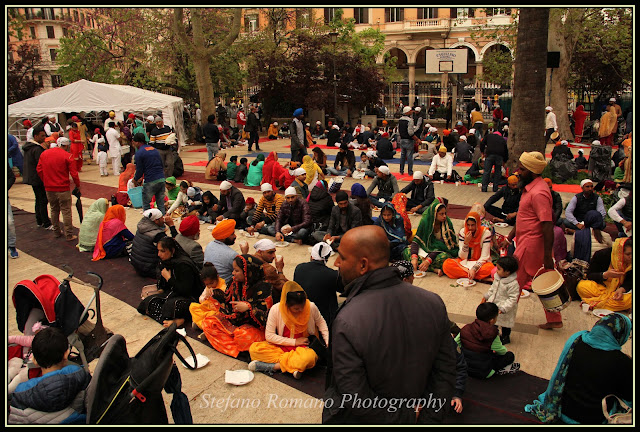 |
| Rome, 23 April 2017 |
April 13 or 14 is the beginning of the new calendar year for the Sikh community (which means “disciple”), the day that commemorates the baptism of the “Panj Piare” (the five devotees) at the hands of the tenth and last guru Gobind Singh, in 1699, from which derives the use of taking the surname “Singh” (lions) for men and “Khaur” (Princesses) for women.
I attended the Nagar Kirtan, the celebration for Vaisakhi, for two consecutive years, in 2017 and 2018, in the historic location of Piazza Vittorio, in the multi-ethnic heart of Rome, a stone's throw from Termini Station.
The Sikh community is not among my main acquaintances, but it's always a pleasure to spend a day with them. They are very helpful and every time they give me many small books to learn about their culture, and it's known to everyone that they are a deeply proud and warrior people.
Unfortunately, in Italy many of us know them above all for their occupation in plantations as laborers, in the Lazio area of Latina, for their physical strength and ability with animals.
But theirs is a very profound culture, and they were also recruited during the First and Second World War by the British to fight the Nazis, especially in France, and they also passed through Italy.
This year, because of Covid-19, no cultural or religious celebration was possible, so the only way to live it with them is to look at the photographs of previous years.
This is my Nagar Kirtan of Sikh in Rome: moments, rites, portraits.
 |
| Piazza Vittorio (Vittorio Square). Rome, 23 April 2017 |
More about Sikh (from Wikipedia):
Nagar Kirtan (Punjabi: ਨਗਰ ਕੀਰਤਨ) is a Sikh custom involving the processional singing of holy hymns throughout a community. While practiced at any time, it is customary in the month of Visakhi (or Vaisakhi). Traditionally, the procession is led by the saffron-robed Panj Piare (the five beloved of the Guru), who are followed by the Guru Granth Sahib, and the holy Sikh scripture – which is placed on a float. Commonly, members of the procession are unshod in deference to the displayed scripture. Likewise, many cover their heads and don the colour saffron or orange. The road before the procession is cleared by Sewadars. Bystanders bow their heads to the scripture. Food may be provided to them from floats that follow the Scripture or from stationary points near the vicinity of the procession. The procession concludes at the Gurudwara with Ardas (pray).
A Sikh is a follower of Sikhism, a monotheistic religion which originated during the 15th century in the Punjab region of Northwestern Indian subcontinent. The term “Sikh” has its origin in the Sanskrit words शिष्य (śiṣya; disciple, student) or शिक्ष (śikṣa; instruction). A Sikh, according to Article I of the Sikh Rehat Maryada (the Sikh code of conduct), is “any human being who faithfully believes in One Immortal Being; ten Gurus, from Guru Nanak to Guru Gobind Singh; Guru Granth Sahib; the teachings of the ten Gurus and the baptism bequeathed by the tenth Guru”.
“Sikh” properly refers to adherents of Sikhism as a religion, not an ethnic group. However, because Sikhism has seldom sought converts, most Sikhs share strong ethno-religious ties. Many countries, such as the United Kingdom, therefore recognize Sikh as a designated ethnicity on their censuses. The American non-profit organization United Sikhs has fought to have Sikh included on the U.S. census as well, arguing that Sikhs “self-identify as an ethnic group” and believe “that they are more than just a religion.”
Male Sikhs have “Singh” (Lion), and female Sikhs have “Kaur” (princess) as their middle or last name. Sikhs who have undergone the khanḍe-kī-pahul (the Sikh initiation ceremony) may also be recognized by the five Ks: Kesh, uncut hair which is kept covered, usually by a turban; kara, an iron or steel bracelet; a kirpan, a sword tucked into a gatra strap or a kamal kasar belt; kachera, a cotton undergarment; and kanga, a small wooden comb. Initiated male and female Sikhs must cover their hair with a turban. The greater Punjab region is the historic homeland of the Sikhs, although significant communities exist around the world.
Sikh art and culture are nearly synonymous with that of the Punjab, and Sikhs are easily recognised by their distinctive turban (Dastar). The Punjab has been called India's melting pot, due to the confluence of invading cultures from the rivers from which the region gets its name. Sikh culture is therefore a synthesis of cultures. Sikhism has forged a unique architecture, which S. S. Bhatti described as “inspired by Guru Nanak's creative mysticism” and “is a mute harbinger of holistic humanism based on pragmatic spirituality.
The Sikh community celebrates its holidays through public processions, which constitute a way to share moments of joy with other communities. The kagans are led by the holy text "GURU GRANTH SAHIB JI", and by 5 consecrated Sikhs.
 |
| Piazza Vittorio (Vittorio Square). Rome, 15 April 2018 |


















Colourful! 😍
ReplyDeleteThanks a lot! Lets travel by eyes...
DeleteInteresting.
ReplyDeleteAlso colourful. 😍
Thanks a lot ...
DeleteOver the years historians have been able to connect Roman trade with the far east specifically India...evidenced by the discovery of Pompei Lakhsmi...and this later made Italy has multi ethnic.
ReplyDeleteYes, and sikh help a lot during the World War to fight nazis...
Deletemenarik dan sarat makna
ReplyDeleteNuhuun!
Delete